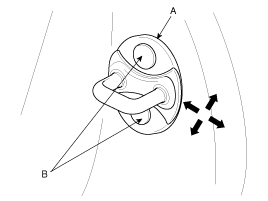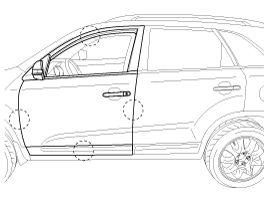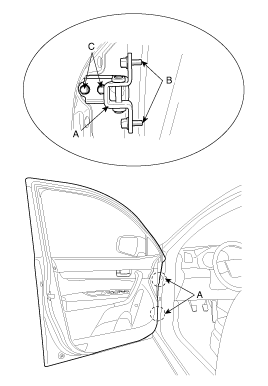Carefully move the glass (A) until the glass mounting bolt are visible, then loosen them.

Check the glass run channel for damage or deterioration, and replace them necessary.
Remove the door trim.
Carefully move the glass (A) until the glass mounting bolt are visible, then loosen them.

Check that the glass moves smoothly.
Make sure the door latches securely without slamming it. If necessary adjust the striker (A): The striker nuts are fixed. The striker can be fine adjusted up or down, and in or out.
Loosen the screws (B), then insert a shop towel between the body and striker.
Tightening torque :
B : 16.7~21.6 N.m (1.7 ~2.2 kgf.m, 12.3~15.9 lb-ft)

Lightly tighten the screws.
Wrap the striker with a shop towel, then adjust the striker by tapping it with a plastic hammer. Do not tap the striker too hard.
Loosen the screws and remove the shop towel.
Lightly tighten the screws.
Hold the outer handle out, and push the door against the body to be sure the striker allows a flush fit. If the door latches properly, tighten the screws and recheck.
After installing the door, check for a flush fit with the body, then check for equal gaps between the front, rear, and bottom, door edges and the body. Check that the door and body edges are parallel. Before adjusting, replace the mounting bolts.
Check that the door and body edges are parallel.

Place the vehicle on a firm, level surface when adjusting the doors.
Adjust at the hinges (A):
Loosen the door mounting bolts slightly, and move the door IN or OUT until it aligns flush with the body.
Loosen the hinge mounting bolts slightly, and move the door backward or forward, up or down as necessary to equalize the gaps.
Place a shop towel on the jack to prevent damage to the door when adjusting the door.
Tightening torque :
B : 21.6~26.5 N.m (2.2 ~2.7 kgf.m, 15.9~19.5 lb-ft)
C : 33.3~41.2 N.m (3.4~4.2 kgf.m, 24.6~30.4 lb-ft)

Check that the door and body edges are parallel.
Grease the pivot portions of the hinges indicated by the arrows.
Check for water leaks.